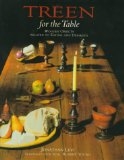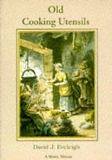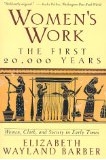-
History of:
- Resources about:
- More:
- Baby walkers
- Bakehouses
- Bed warmers
- Beer, ale mullers
- Besoms, broom-making
- Box, cabinet, and press beds
- Butter crocks, coolers
- Candle snuffers, tallow
- Clothes horses, airers
- Cooking on a peat fire
- Drying grounds
- Enamel cookware
- Fireplaces
- Irons for frills & ruffles
- Knitting sheaths, belts
- Laundry starch
- Log cabin beds
- Lye and chamber-lye
- Mangles
- Marseilles quilts
- Medieval beds
- Rag rugs
- Rushlights, dips & nips
- Straw mattresses
- Sugar cutters - nips & tongs
- Tablecloths
- Tinderboxes
- Washing bats and beetles
- Washing dollies
- List of all articles
Subscribe to RSS feed or get email updates.
Jonathan Levi, Treen for the Table: Wooden Objects Relating to Eating and Drinking, from Amazon.comor Amazon UK

Old Cooking Utensils by David Eveleigh, from Amazon.comor Amazon UK


Elizabeth Barber, Women's Work: The First 20,000 Years Women, Cloth, and Society in Early Times, from Amazon.comor Amazon UK

Snippets from the home page - April 2012
More snippets: February and March 2012
What is it?

Click on the picture to find out what these were used for.
Did you know?
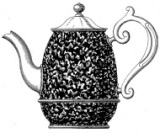
Civil War re-enactors in the US discourage people from bringing speckled enamel
cookware to events. Although it's thought of as "traditional" American graniteware,
it arrived a bit too late to be authentic in the context. Mottled
enamelware in the USA only goes back to about the mid-1870s, with the first
patent in 1876.
Home life in art
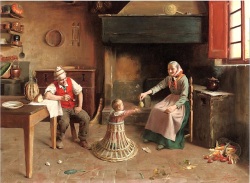 The child is
centre of attention for its doting grandparents, for the artist, Sandrucci, and
for us. She's in an interesting wickerwork baby
walker. That
kind of "walker" (Italian or French) never looks like a very good way
of helping an infant learn to walk - but I've never seen one in action. Did it have
more to do with teaching it to stand upright? With keeping an active baby contained
and safe? Anyway, it's an appealing 19th century Italian kitchen scene: terracotta
floor, wine flask, big fireplace, and many more nice details that catch the eye.
Was the stray vegetable leaf left on the floor for artistic reasons?
The child is
centre of attention for its doting grandparents, for the artist, Sandrucci, and
for us. She's in an interesting wickerwork baby
walker. That
kind of "walker" (Italian or French) never looks like a very good way
of helping an infant learn to walk - but I've never seen one in action. Did it have
more to do with teaching it to stand upright? With keeping an active baby contained
and safe? Anyway, it's an appealing 19th century Italian kitchen scene: terracotta
floor, wine flask, big fireplace, and many more nice details that catch the eye.
Was the stray vegetable leaf left on the floor for artistic reasons?
Growing clothesline posts
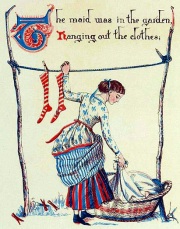 Have any green
readers got a living, growing clothesline? This picture only just begins to illustrate
Esther Copley's 1840 advice for drying laundry outside:
"The next thing....is some posts for your wife to dry her linen....I will tell
you of something very cheap....If you get some fresh cut, straight willow poles,
about as thick as your arm, cut off all the twigs, except about half a dozen just
round the top, which may be left five or six inches in length, dig a hole at the
corners of your garden, and set in the posts; put them as much as a foot in the
ground, set them fast with large stones, and fill up the mould round them; and there
you have good, strong, living, growing posts, that will serve you for many years
— this I know by experience. The twigs at top will serve to fix the line by."
Have any green
readers got a living, growing clothesline? This picture only just begins to illustrate
Esther Copley's 1840 advice for drying laundry outside:
"The next thing....is some posts for your wife to dry her linen....I will tell
you of something very cheap....If you get some fresh cut, straight willow poles,
about as thick as your arm, cut off all the twigs, except about half a dozen just
round the top, which may be left five or six inches in length, dig a hole at the
corners of your garden, and set in the posts; put them as much as a foot in the
ground, set them fast with large stones, and fill up the mould round them; and there
you have good, strong, living, growing posts, that will serve you for many years
— this I know by experience. The twigs at top will serve to fix the line by."
Tinderboxes were essential for centuries, but disappeared in a generation once matches were invented. Young people in the mid-19th century couldn't strike a light the way their elders once had.
What was the "most disagreeable item in domestic labor" according to Catharine Beecher? And which invention of the Rev. Henry Moule's helped relieve the problem?
You may like our new sister site Home Things Past where you'll find articles about antiques, vintage kitchen stuff, crafts, and other things to do with home life in the past. There's space for comments and discussion too. Please do take a look and add your thoughts. (Comments don't appear instantly.)
For sources please refer to the books page, and/or the excerpts quoted on the pages of this website, and note that many links lead to museum sites. Feel free to ask if you're looking for a specific reference - feedback is always welcome anyway. Unfortunately, it's not possible to help you with queries about prices or valuation.


